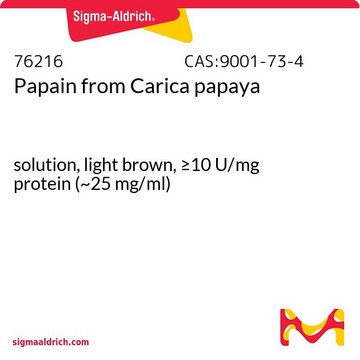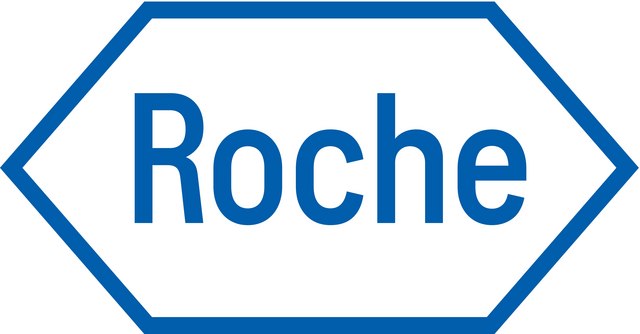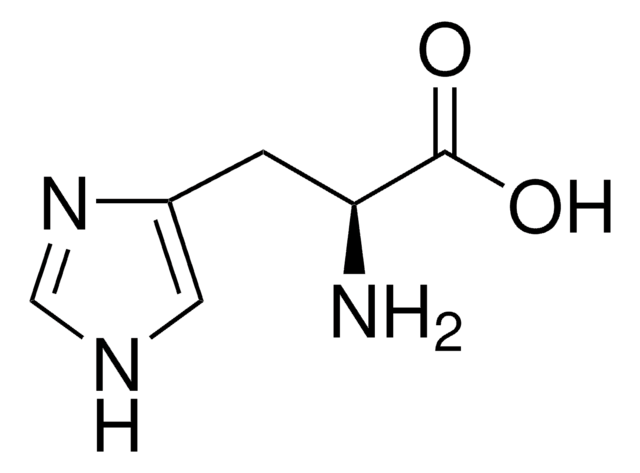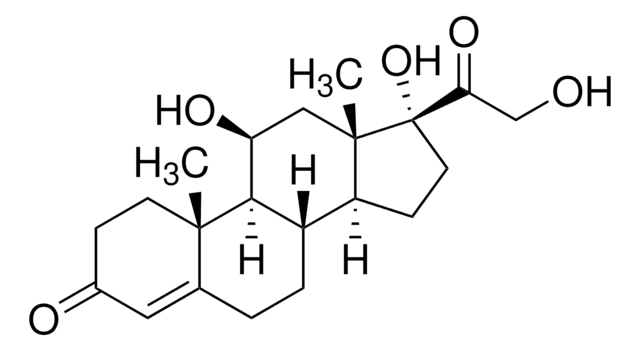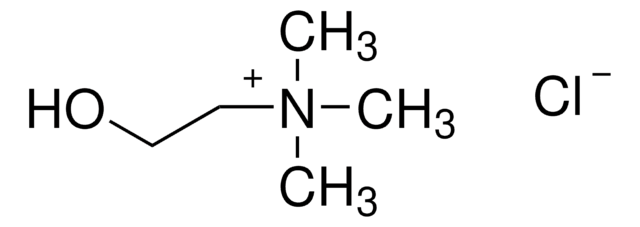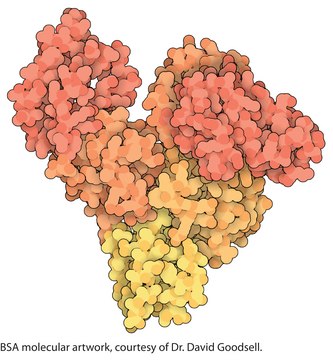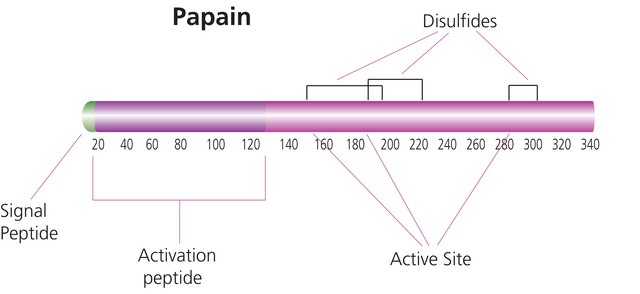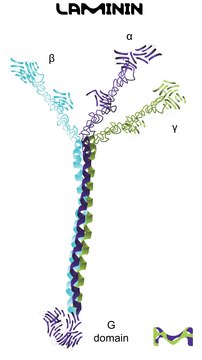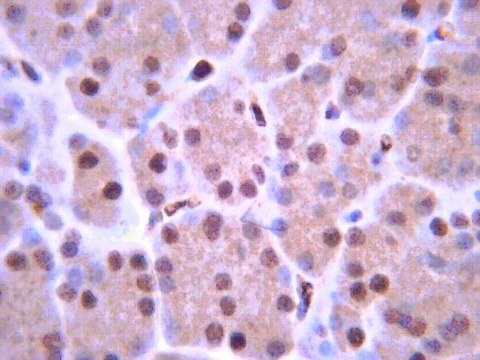推荐产品
生物来源
human
质量水平
重组
expressed in E. coli
描述
0.1 mg recombinant human CDH13 in 20 mM Tris-HCl buffer containing NaCl, KCl, EDTA, L-arginine, DTT and glycerol.
无菌性
Filtered sterilized solution
方案
≥90% (SDS-PAGE)
表单
liquid
包装
pkg of 100 μg
浓度
0.5 mg protein/mL
技术
cell culture | mammalian: suitable
登记号
NP_001248
运输
dry ice
储存温度
−20°C
基因信息
human ... CDH13(1012)
应用
Coating a plate well (6 well plate) with this recombinant CDH13 protein in a neuronal cell specific medium at 1-10 mg / well allows for 1) human neuronal cell and vascular endothelial cell / receptor interaction studies or 2) human neuronal and vascular endothelial cell/receptor interaction studies in vitro.
Use this procedure as a guideline to determine optimal coating conditions for the culture system of choice.
1. Thaw CDH13 and dilute to desired concentration using serum-free medium or PBS. The final solution should be sufficiently dilute so that the volume added covers the surface evenly (1-10 μg/well, 6 well plate).
2. Add appropriate amount of diluted material to culture surface.
3. Incubate at room temperature for approximately 1.5 hours.
4. Aspirate remaining material.
5. Rinse plates carefully with water and avoid scratching bottom surface of plates.
6. Plates are ready for use. They may also be stored at 2-8 °C damp or air dried if sterility is maintained.
Use this procedure as a guideline to determine optimal coating conditions for the culture system of choice.
1. Thaw CDH13 and dilute to desired concentration using serum-free medium or PBS. The final solution should be sufficiently dilute so that the volume added covers the surface evenly (1-10 μg/well, 6 well plate).
2. Add appropriate amount of diluted material to culture surface.
3. Incubate at room temperature for approximately 1.5 hours.
4. Aspirate remaining material.
5. Rinse plates carefully with water and avoid scratching bottom surface of plates.
6. Plates are ready for use. They may also be stored at 2-8 °C damp or air dried if sterility is maintained.
序列
MASMTGGQQMGRGHHHHHHGNLYFQGGEFELSIVVSPILIPENQRQPFPRDVGKVVDSDRPERSKFRLTGKGVDQEPKGIFRINENTGSVSVTRTLDREVIAVYQLFVETTDVNGKTLEGPVPLEVIVIDQNDNRPIFREGPYIGHVMEGSPTGTTVMRMTAFDADDPATDNALLRYNIRQQTPDKPSPNMFYIDPEKGDIVTVVSPALLDRETLENPKYELIIEAQDMAGLDVGLTGTATATIMIDDKNDHSPKFTKKEFQATVEEGAVGVIVNLTVEDKDDPTTGAWRAAYTIINGNPGQSFEIHTNPQTNEGMLSVVKPLDYEISAFHTLLIKVENEDPLVPDVSYGPSSTATVHITVLDVNEGPVFYPDPMMVTRQEDLSVGSVLLTVNATDPDSLQHQTIRYSVYKDPAGWLNINPINGTVDTTAVLDRESPFVDNSVYTALFLAIDSGNPPATGTGTLLITLEDVNDNAPFIYPTVAEVCDDAKNLSVVILGASDKDLHPNTDPFKFEIHKQAVPDKVWKISKINNTHALVSLLQNLNKANYNLPIMVTDSGKPPMTNITDLRVQVCSCRNSKVDCNAAG
制备说明
The full-length extracellular domain of the human CDH13 gene (139-693 aa) was constructed with 31 N-terminal T7/HIS-tag and expressed in E. coli as inclusion bodies. The final product was refolded using our unique “temperature shift inclusion body refolding” technology and chromatographically purified.
储存分类代码
10 - Combustible liquids
WGK
WGK 2
闪点(°F)
Not applicable
闪点(°C)
Not applicable
法规信息
常规特殊物品
Danila Ivanov et al.
Experimental cell research, 293(2), 207-218 (2004-01-20)
T-cadherin (T-cad), an unusual glycosylphosphatidylinositol (GPI)-anchored member of the cadherin family of cell adhesion molecules, is widely expressed in the cardiovascular system. The expression profile of T-cad within diseased (atherosclerotic and restenotic) vessels indicates some relationship between expression of T-cad
Cristina Vergara et al.
Acta neuropathologica, 137(3), 397-412 (2019-01-02)
Neuropathological analysis in Alzheimer's disease (AD) and experimental evidence in transgenic models overexpressing frontotemporal dementia with Parkinsonism linked to chromosome 17 (FTDP-17) mutant tau suggest that amyloid-β pathology enhances the development of tau pathology. In this work, we analyzed this
Alexandra V Andreeva et al.
Journal of cellular physiology, 223(1), 94-102 (2009-12-30)
T-cadherin is an atypical member of the cadherin family, which lacks the transmembrane and intracellular domains and is attached to the plasma membrane via a glycosylphosphatidylinositol anchor. Unlike canonical cadherins, it is believed to function primarily as a signaling molecule.
Sujita Khanal et al.
PLoS pathogens, 15(2), e1007442-e1007442 (2019-03-01)
Persistent expression of high-risk HPV oncogenes is necessary for the development of anogenital and oropharyngeal cancers. Here, we show that E6/E7 expressing cells are hypersensitive to DNA crosslinking agent cisplatin and have defects in repairing DNA interstrand crosslinks (ICL). Importantly
Ada Ndoja et al.
Cell, 182(5), 1156-1169 (2020-08-17)
Dysregulated microglia are intimately involved in neurodegeneration, including Alzheimer's disease (AD) pathogenesis, but the mechanisms controlling pathogenic microglial gene expression remain poorly understood. The transcription factor CCAAT/enhancer binding protein beta (c/EBPβ) regulates pro-inflammatory genes in microglia and is upregulated in
我们的科学家团队拥有各种研究领域经验,包括生命科学、材料科学、化学合成、色谱、分析及许多其他领域.
联系技术服务部门